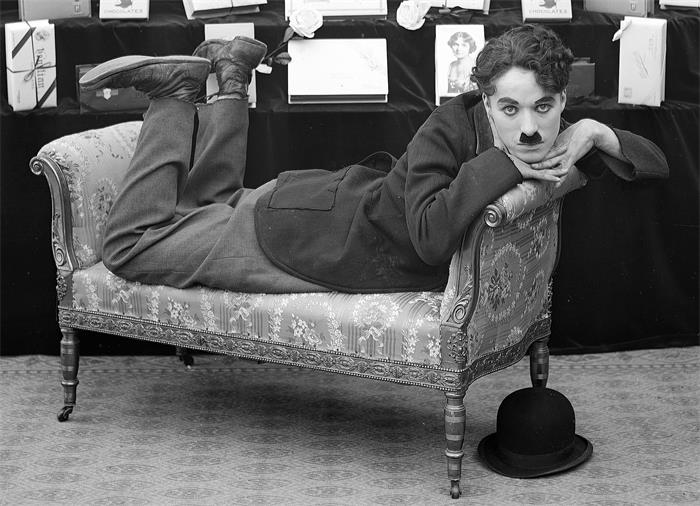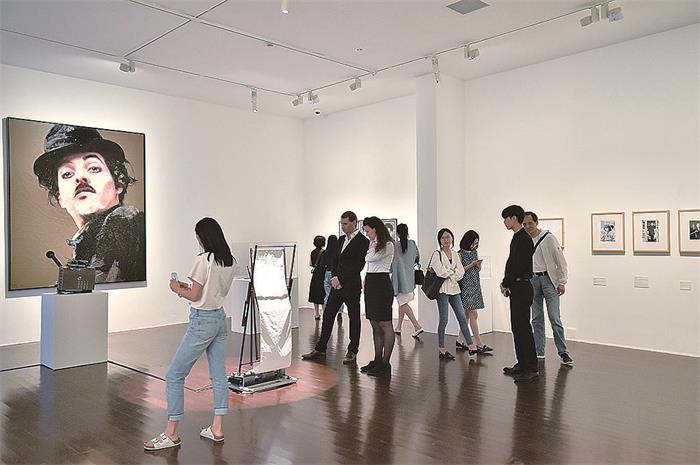
The exhibition contains more than 300 photographs and documents from the Chaplin’s Archive that showcase the artist’s lifelong contribution to modern comedy. (Photo:China Daily)
A new exhibition documenting the life of English comic actor Charlie Chaplin is being shown at the Yuz Museum in Shanghai before it goes onto a global tour in November
Many people would remember Charlie Chaplin as the funny character with the baggy pants, bowler hat and oversized shoes who waved his cane around and walked with a funny spring in his step.
A new exhibition at Yuz Museum, however, portrays the character in a different light — as one of the greatest artists ever to grace the silver screens.
The exhibition Charlie Chaplin: A Vision was jointly produced by the Musee de l'Elysee in Lausanne, Switzerland, and the Yuz Museum on West Bund in Xuhui district. The exhibition, which opened on June 8, will go on for four months at the Yuz Museum in Shanghai till Oct 7. It will then embark on an international tour, starting with Mexico City in November.

Born in England in 1889, six years before the birth of the cinema, Chaplin began making films in 1914 and his first feature-length film The Kid debuted in theaters across Shanghai in 1921, endearing him to local audiences. Such was his popularity that Shanghai's Mingxing Film Studio, one of the first in China, made a film about a Chaplin-like character visiting the city in 1922.
The show featured a Western actor imitating Chaplin's signature performance. Professor Tang Weijie of Tongji University, a scholar in film history, said that this show marked the beginning of China's film industry.
In 1931, Chaplin visited the Far East and met with famous artists such as Peking Opera singer Mei Lanfang in Shanghai.
"Even today, a photograph of Chaplin visiting the Xinguang Theatre still hangs in the old cinema located just off Nanjing Road in the city center," said Tang.

Chaplin started his career as one of the Eight Lancashire Lads, a troupe of clog dancing boys, in London when he was just 9 years old. His parents, who were both performers, later succumbed to alcoholism and mental illness. This was when Charlie and his brother were sent to an orphanage. In 1908, Chaplin started working for Fred Karno, a manager of a preeminent British pantomime company who eventually brought him to the US. In 1913, Chaplin accepted a lucrative offer to join the Keystone Film Company.
The Englishman began his film career in the costume that would later make him famous. Throughout the years, Chaplin constantly refined the character, introducing romance and tenderness to his story.
In 1917, Chaplin built his own studio where he was able to take control of every aspect in the production process, from the use of the props to the movements.
According to Tatyana Franck, director of the Musee de l'Elysee and the curator of the exhibition, Chaplin's acting repertoire hit a new level of virtuosity in films such as The Gold Rush, The Circus and City Lights. Meanwhile, the movies that followed, Modern Times and The Great Dictator, showcased the artist's profound reflections of current events.
In the 1950s, Chaplin was forced to leave the United States after facing accusations of sympathizing with the Communists. He then moved to Switzerland where he lived with his fourth wife Oona O'Neill and their eight children until he died in 1977. During these two decades, his movies continued to be screened in China even though most Western films were banned.
"His movies provided a rare glimpse of the Western world for Chinese audiences at that time," said Tang about why Chaplin was so well-loved in China.
Today, Chaplin is remembered as "the founder of modern comedy and one of the most influential performing artists and film directors of the 20th century", according to Franck.
The Charles Chaplin photographic archive was entrusted to the Musee de l'Elysee, one of the world's leading museums dedicated to photographic works, in January 2011 by the Chaplin Association and Roy Export SAS. The archive contains some 20,000 negatives, prints and original albums that document Chaplin's career and private life.

Visitors attend the Charlie Chaplin exhibition at the Yuz Museum on West Bund, Shanghai. (Photo:China Daily)
The Yuz Museum's move to collaborate with the Musee de l'Elysee came about in 2015 when Budi Tek, an Indonesian entrepreneur and founder of the Yuz, saw curators working on Chaplin's photographs during a trip to the Swiss museum.
Franck and her fellow curators from the Musee de l'Elysee have designed the exhibition to span seven chapters arranged in chronological order. Visitors to the exhibition will find more than 300 photographs and documents from the Chaplin's Archive, as well as two hours' worth of film clips and items that highlight the Englishman's influence on the international art scene.
At the opening of the exhibition in Shanghai, Franck said that the show aims to explore the way Chaplin saw the world he lived in, the unique bond he created with his audience, the way he revolutionized the industry that made him famous and how he created images that "condensed the short century like a message in a bottle for present generations".
"Very few filmmakers have been able to reach the heart of the human condition like Chaplin did. He left us with a number of iconic scenes that visually encapsulate the pursuit of happiness, the hunger, the wars, the alienation and the madness of the 20th century. Chaplin's vision transcended his time…just as his character continues to be the subject of contemporary art and representation," she said.
French designer Adrien Gardere created the layout of the exhibition, marking the fourth time he has worked with the Yuz Museum. Gardere explained that he has placed the manuscripts and pictures with the movie extracts in a way that creates a dialogue between them. Audiences are also encouraged to experience Chaplin's life and career through the film abstracts that are projected onto the screens in the central space of each exhibition hall.
The last chapter of the exhibition features creations by artists that were inspired by Chaplin. Some of those featured are the late Belgian poet and filmmaker Marcel Broodthaers as well as contemporary Chinese artists like Zhou Tiehai and Liu Silin.
The central hall on the ground floor of the Yuz Museum has also been transformed into a temporary cinema for the exhibition, with five of Chaplin's movies being shown: The Kid, Modern Times, City Lights, The Great Dictator and The Circus. Visitors can visit the museum's website to find out which film is being shown on the day of their planned visit.


